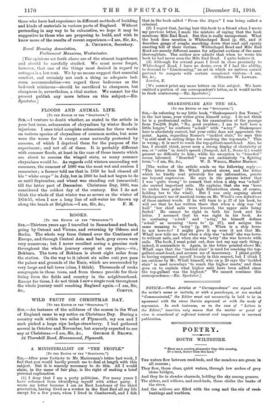SHAKESPEARE AND THE SEA.
[To THE EDITOR OP THE "SPECTATOR."] She,,—In referring to my little book, "Shakespeare's Sea Terms," in the last issue, your writer gives himself away. I do not think he is a professional sailor. In his examination of the passage from Twelfth Night, "No, good swabber; I am to hull here a little longer," he confuses "a-hull" with "a-try." Shakespeare here is absolutely correct, but your critic does not appreciate the point. Again, regarding Romeo's "tackled stair," he says this "is still used in sailing ships for reaching the top-masts." This is wrong; it is used to reach the top-gallant-mast-head. Also, he has, I should think, never seen a strong display of electricity at sea, or "cabin" in Arias speech (Tempest, Act I., Scene would present no difficulty to him ; while his exception to "boarded" seems laboured. "Boarded" was not exclusively "a. fighting term."—I am, Sir, &c., W. B. WHarra Master Mariner.
[The writer of the article sends us the following reply :— " The letter from Mr. Whall printed above, and the letter which he kindly sent privately for my information, puzzle me beyond expression. He says in the private letter that I was quite wrong' to remark that when a ship was `a-hull' she carried important sails. He explains that she was hove to under bare poles' (the high Elizabethan stern, of course, holding her to the wind). But I was only arguing about Shakespeare's use of nautical terms on Mr. Whall's own definitions of these ancient words. If he will turn to p. 27 of his book, he will see that he has written there that when a ship was 'at hull' her chief sails were lowered, the upper sails being furled.' He cannot be right in both his book and his letter. I assumed that he was right in his book. As to confusing a-hull and a-try, he himself defines ' a-hull ' as meaning 'hove to' (p. 27), and assigns the same meaning to`a-try' (p. 98). When is a ship hove- to not hove-to ? I might give it up were it not that Mr. Whall now tells me that when a ship was `a-hull' she was hove- to without sails, and when she was `a-try' she was hove-to with sails. The book, I must point out, does not say any such thing ; indeed, it contradicts it. Again, in the letter printed above Mr. Whall says that the tackled stair' is used for reaching the top- gallant-mast-head, and accuses me of inaccuracy. I plead guilty to having expressed myself loosely in this respect, but I think I am outdone by Mr. Whall himself, who on p. 29 says the 'tackled stair' is used nowadays 'to reach the higher masts,' and then goes on to explain what higher sails have been added since the top-gallant was the highest." We cannot continuo this correspondence.—En. Spectator.]






































 Previous page
Previous page